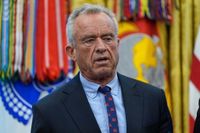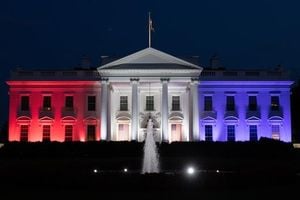On October 15, 2025, a new chapter in America’s ongoing battle over public health policy unfolded as governors from 15 Democratic-led states announced the creation of a "shadow" public health alliance. This coalition, first reported by The Wall Street Journal and discussed in a recent Slate Magazine podcast, aims to counteract what its members see as punitive federal actions and a worrying shift in national health policy under the current administration.
The alliance, spearheaded by Massachusetts Governor Maura Healey, brings together leaders from California, Colorado, Connecticut, Delaware, Guam, Hawaii, Illinois, Maryland, New Jersey, North Carolina, New York, Oregon, Rhode Island, and Washington. Collectively, these states—and territory—represent roughly 115 million Americans, about a third of the nation’s population, according to The Wall Street Journal.
Governor Healey, speaking at the State House in Boston last month, laid out her state’s position with characteristic clarity. “We are taking a stand. We are a health care leader, and we’re not going to let the Trump administration or Robert Kennedy cost lives and take us down when others fail to do their job,” she declared. Her comments came amid growing concerns among Democratic leaders that federal policy changes and funding cuts under Health and Human Services Secretary Robert F. Kennedy Jr. and President Donald Trump were jeopardizing the welfare of their citizens.
At the same news conference, Healey signaled the coming together of this interstate compact, noting that Massachusetts intended to partner with other New England and northeastern states on vaccine access and broader public health initiatives. The alliance, she explained, was a direct response to what many blue-state leaders view as a federal government increasingly hostile to Democratic priorities and scientific consensus.
California Governor Gavin Newsom echoed this sentiment in a statement from his office: “California is proud to help launch this new alliance because the American people deserve a public health system that puts science before politics.” Newsom—no stranger to public clashes with President Trump—continued, “As extremists try to weaponize the [Centers for Disease Control and Prevention] and spread misinformation, we’re stepping up to coordinate across states, protect communities, and ensure decisions are driven by data, facts, and the health of the American people.”
This new coalition is not just a symbolic gesture. The governors have committed to sharing data, resources, and lessons learned to strengthen their preparedness for future public health challenges. Delaware Governor Matt Meyer highlighted the practical benefits: “The joint effort will allow the governors to share data, resources, and lessons learned to strengthen our preparedness for the next public health challenge. Delaware is proud to join this effort to make our state—and our nation—safer and healthier.”
Colorado Governor Jared Polis, speaking to The Wall Street Journal, underscored the urgency of the moment. He pointed out that as more expertise is cut from federal agencies like the CDC and Food and Drug Administration, states will increasingly need to step up to fill the void. “It’s really just about public health,” Polis said, emphasizing the nonpartisan nature of the work despite the political context.
New York Governor Kathy Hochul was equally adamant about the alliance’s mission. “We have to show that we will continue supporting science, supporting medical research, supporting our institutions, supporting access to vaccinations, and we believe in science,” Hochul told the newspaper. Her remarks reflect a broader anxiety among Democratic leaders that the federal government’s changing stance on public health could have dire consequences for millions of Americans.
Behind the scenes, the alliance is already reaching out to other governors, including some Republicans, in hopes of expanding their coalition. According to The Wall Street Journal, the group’s leaders believe that public health should transcend partisan divides, even as the current political climate makes such unity increasingly elusive.
Not everyone is convinced of the alliance’s motives or effectiveness. A spokesperson for the U.S. Health and Human Services Department told The Wall Street Journal that the agency would ensure its vaccine-advisory panel’s policies remain “based on rigorous evidence and Gold Standard Science, not the failed politics of the pandemic.” The spokesperson went further, criticizing Democratic-led states for their handling of the COVID-19 crisis: “Democrat-run states that pushed unscientific school lockdowns, toddler mask mandates, and draconian vaccine passports during the COVID era completely eroded the American people’s trust in public health agencies.”
This sharp rebuke underscores the deep divisions that continue to shape America’s public health landscape. For supporters of the alliance, the move is a necessary bulwark against what they see as a dangerous federal retreat from science and evidence-based policy. For critics, it’s a political ploy by states that, in their view, mismanaged the pandemic and are now seeking to undermine federal authority.
The idea of states banding together to resist federal policy is not entirely new. Throughout American history, state-federal tensions have flared over issues ranging from civil rights to environmental regulation. But the current moment feels especially charged, as public health—once seen as a largely technocratic field—has become a central battleground in the country’s partisan wars.
Some commentators have even floated the notion of a “soft secession” by blue states, as discussed in a recent Slate Magazine podcast. While no one is seriously advocating for actual secession, the term captures a growing sense among some Democratic leaders and voters that their states must chart their own course if the federal government is, in their eyes, punishing them for their political leanings.
What’s next for the alliance? For now, the governors are focused on immediate steps: coordinating public health messaging, pooling resources for vaccine procurement, and developing shared strategies for future crises. They also hope to serve as a model for bipartisan cooperation, even as national politics remain deeply polarized.
As the alliance takes shape, the stakes could hardly be higher. With memories of the COVID-19 pandemic still fresh and new public health threats always on the horizon, the question of who sets the rules—and who is trusted to protect the public—has never felt more urgent. Whether this coalition of blue states can bridge the nation’s divides or will only deepen them remains to be seen. But one thing is clear: the battle over America’s public health future is far from over.
With both sides digging in, the coming months promise more debate, more maneuvering, and, perhaps, a few surprises as states and the federal government vie for the trust—and the health—of the American people.




